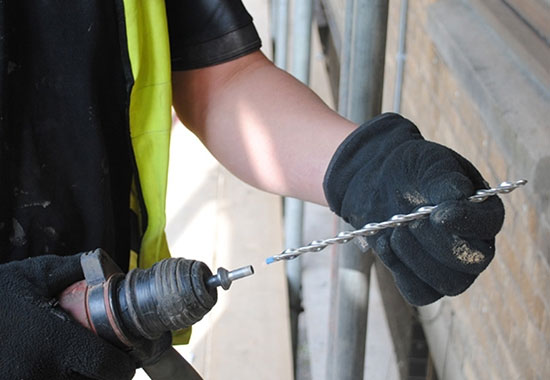Cavity wall tie surveys

Our skilled wall tie specialist will expertly survey the property and give a professional diagnosis in a written report, confirming the extent of the problem. We will take time and care with conducting the external inspection, and produce a report that is thorough and detailed.
We assess the condition of the ties under an industry visual grading guideline, typically following the BRE Digest 401. If the report finds that the condition of the ties to be failing in line with BRE 401 or, if there are factors which require acceleration of the timescale for wall tie replacement (impending cavity wall insulation for example), a wall tie replacement specification and a quotation will be issued as part of your wall tie report.
Remedial tie installation
Since 1950 the cavity wall has become the standard form of construction for housing and buildings of a similar scale. It splits the traditional nine inch masonry wall into two leaves of four and a half inch brick. Wall ties impart stability to the outer leaf, holding the wall in place. They are also designed to improve weather resistance by accommodating small movements from temperature fluctuations, and preventing outside water transfer.
Unfortunately, as the Property Care Association note, most masonry materials are porous so it is often the case that the wall ties corrode before the masonry is affected. Construction issues may also lead to wall tie failure. Signs of failure include: a pattern of horizontal cracks coinciding with the tie positions/brick wall blowing out/damaged window reveals/sagging or lifting lintels.If you wall ties are failing, we can expertly install remedial ties. To do so, we identify the positions of existing ties, install replacement ties in positions staggered from the originals to restore structural stability, then treat the old ties to prevent any further damage from expansive corrosion.
Structural repairs
In the course of remedial work it is usually possible to bring older buildings up to modern standards with the use of lateral restraints to secure floors and roofs to the masonry, and the use of bed joint reinforcement (BRE:29 and 62). Repointing of the masonry too will enhance its stability and should be considered as part of the work. To prevent water ingress from rusting of wall ties, we can apply external waterproofing treatments on outer leaf walls.
Cavity wall insulation removal
If cavity wall insulation has been poorly or inappropriately fitted, it may lead to problems of damp and condensation. If this has been the case, it is likely that it will have to be removed. Although this may be a frustrating expense for customers who had it installed in good faith, thinking that it would save them money, it may be necessary to stop further issues in the future.